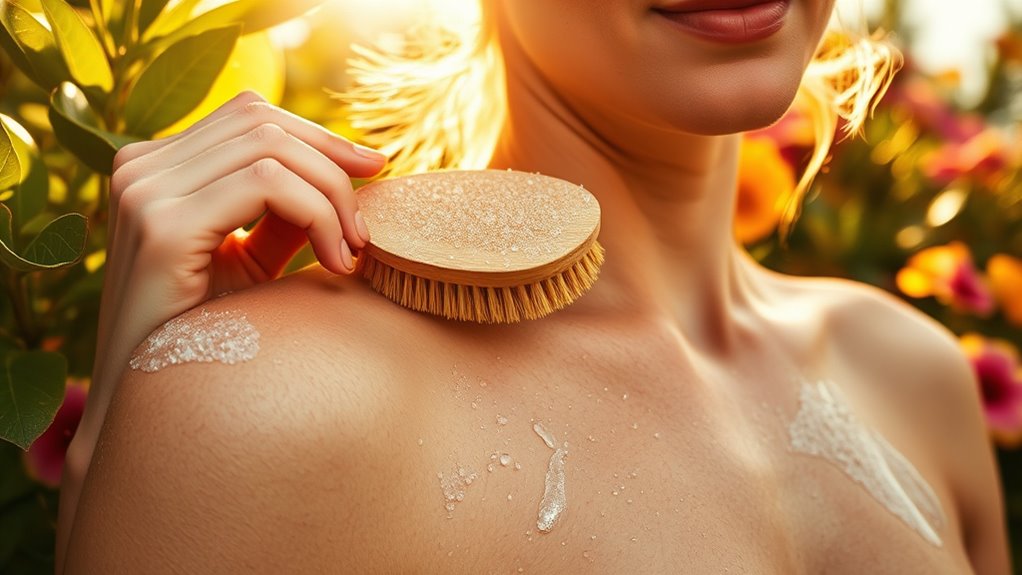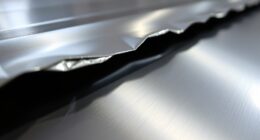After summer, focus on repairing your skin by using gentle exfoliants to remove dead cells and boost absorption of moisturizers and sunscreens. Hydrate well with water and include hydrating foods like citrus and cucumbers. Switch to richer moisturizers suited for cooler weather and apply broad-spectrum sunscreen daily to protect against UV rays. Using soothing after-sun products can help repair damage. Keep caring for your skin, and you’ll find even more tips to restore your glow.
Key Takeaways
- Continue daily broad-spectrum sunscreen application to protect skin from residual UV damage.
- Incorporate hydrating foods and moisturizers to restore skin elasticity after summer heat.
- Gently exfoliate to remove dead cells and enhance absorption of skincare products.
- Use soothing treatments like aloe vera for sun-exposed or irritated skin.
- Reassess skincare routines, switching to richer products for cooler months and overall skin recovery.

Have you ever wondered why seasonal maintenance is essential for your home and belongings? It’s not just about fixing things or cleaning up—it’s also about taking care of yourself, especially your skin, as the seasons change. Late summer can be tough on your skin, with prolonged sun exposure and heat that can lead to damage and dehydration. This makes it the perfect time to focus on recovery routines that help your skin bounce back and stay healthy. One of the most vital steps is ensuring you prioritize sun protection. Even if you’ve been diligent during the summer, the lingering sun rays can continue to cause harm. Applying broad-spectrum sunscreen daily becomes a non-negotiable habit, especially on your face, neck, and any exposed areas. Wearing protective clothing, wide-brim hats, and sunglasses can further shield your skin from harmful UV rays, preventing premature aging, sun spots, or worse, skin cancer. Additionally, your skin needs to be hydrated from the inside out. Hydration routines become crucial as the heat can dehydrate your body and skin alike. Drinking plenty of water throughout the day helps maintain the skin’s elasticity and flushes out toxins that can cause dullness or breakouts. Incorporate hydrating foods such as watermelon, cucumbers, and citrus fruits into your diet, which can boost hydration naturally. Using a good moisturizer tailored to your skin type also helps lock in moisture, especially if you notice dryness or flakiness after summer. Don’t forget to gently exfoliate to remove dead skin cells, revealing fresh, healthier skin underneath. This process not only improves your skin’s appearance but also enhances the effectiveness of your hydrators and sunscreens. As you transition into late summer, it’s wise to reassess your skincare routine, replacing lighter products with richer ones suitable for the changing weather. Your skin’s recovery depends on consistency—make sun protection and hydration routines a daily habit. If you’ve spent a lot of time outdoors, consider integrating soothing after-sun products or aloe vera gels to calm irritated skin. Remember, the goal is to repair any damage caused by sun exposure and dehydration, restoring your skin’s natural glow and resilience. Also, paying attention to color accuracy in your skincare products can ensure that your skin tone looks even and healthy. Taking these simple, effective steps can make a significant difference in how your skin looks and feels. By committing to proper sun protection and hydration routines, you’ll not only recover from late summer’s harsh effects but also prepare your skin for the upcoming seasons, ensuring it stays healthy, vibrant, and protected year-round.
Frequently Asked Questions
How Can I Tell if My Skin Needs Extra Hydration?
If your skin feels tight, looks dull, or shows signs of flakiness or redness, it probably needs extra hydration. You might notice skin dryness, rough patches, or increased sensitivity. These hydration signs indicate your skin isn’t getting enough moisture. To help, incorporate hydrating serums or moisturizers into your routine and drink plenty of water. Keeping your skin well-hydrated helps restore its glow and resilience, especially after summer.
Are There Specific Products Recommended for Late Summer Skin Recovery?
Think of your skin like a garden after summer’s heat—you need nourishing, revitalizing products to help it flourish again. For late summer recovery, look for products with ingredient focus like hyaluronic acid for hydration, antioxidants such as vitamin C, and soothing agents like aloe vera. Recommended products include hydrating serums, gentle exfoliants, and replenishing moisturizers. These will restore your skin’s glow and prepare it for the cooler months ahead.
How Often Should I Exfoliate During Late Summer?
You should exfoliate 2 to 3 times a week during late summer to maintain a healthy skin renewal frequency. This schedule helps remove dead skin cells, brighten your complexion, and prepare your skin for upcoming seasonal changes. Be gentle, especially if your skin feels sensitive from sun exposure. Adjust your exfoliation routine based on how your skin responds; over-exfoliating can cause irritation. Consistency is key for ideal late summer skin recovery.
Can Seasonal Changes Affect My Skincare Allergies?
Yes, seasonal changes can impact your skincare allergies. As seasons shift, your skin may become more sensitive, leading to increased reactions to allergens. You might notice a rise in skin sensitivity or seasonal allergy symptoms, which can worsen allergies or cause new skin issues. To manage this, switch to gentler skincare products, avoid known triggers, and keep your skin moisturized. Stay vigilant and adjust your routine accordingly to protect your skin during seasonal progressions.
What Are Quick Remedies for Sun-Damaged Skin?
Ever notice how a splash of aloe vera can soothe sun-damaged skin? That’s a natural remedy you can try right away. Apply aloe or honey for instant relief. If you’re seeking faster results, consider gentle chemical treatments like glycolic acid to exfoliate damaged skin. Remember, keeping your skin moisturized, wearing sunscreen daily, and avoiding further sun exposure helps. These quick remedies support your skin’s recovery, restoring its natural glow effectively.
Conclusion
As you wrap up your late summer skin recovery, remember that consistent seasonal maintenance can boost your skin’s resilience. Did you know that skin renewal rates slow by up to 28% during autumn? By adopting a targeted routine now, you help your skin adapt and thrive through seasonal changes. Keep up your efforts, stay hydrated, and embrace the shift—your skin will thank you with a healthy, radiant glow year-round.








